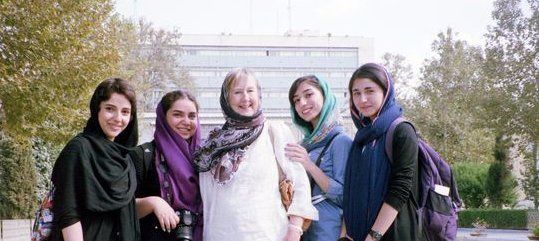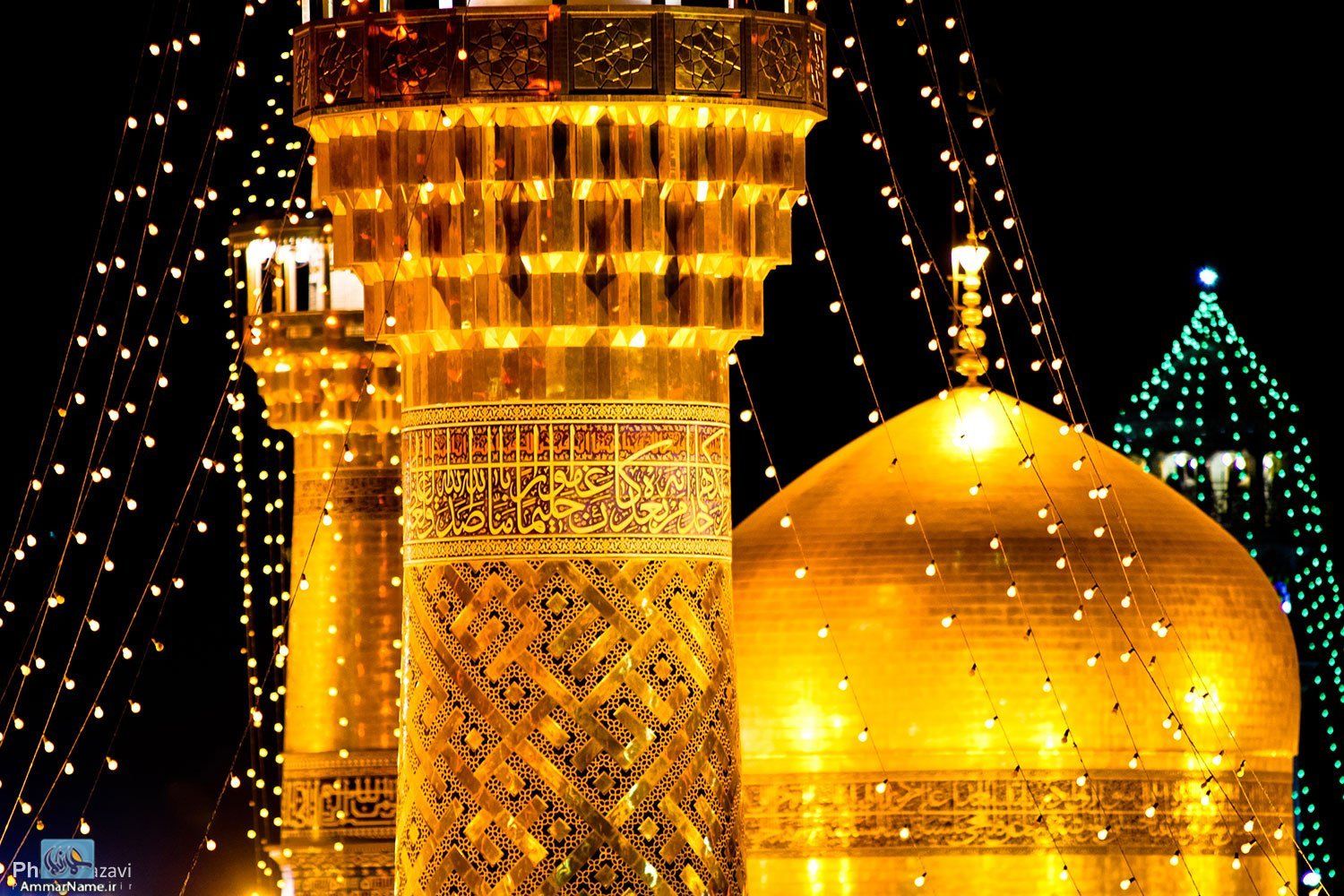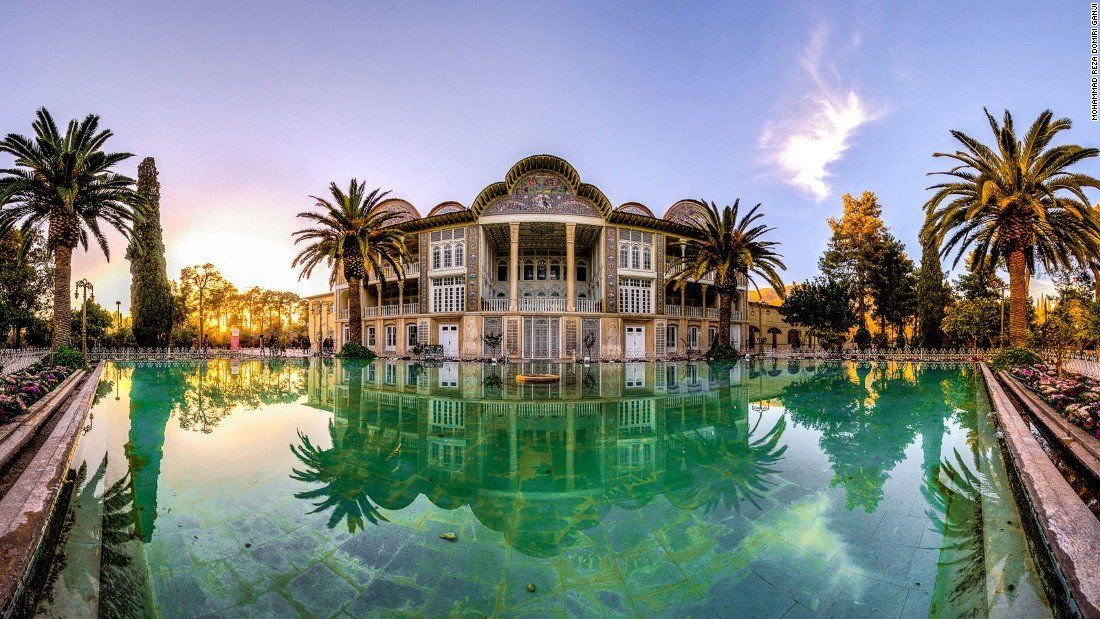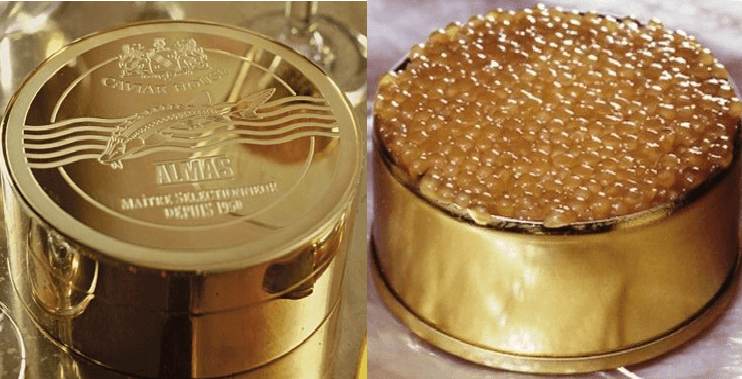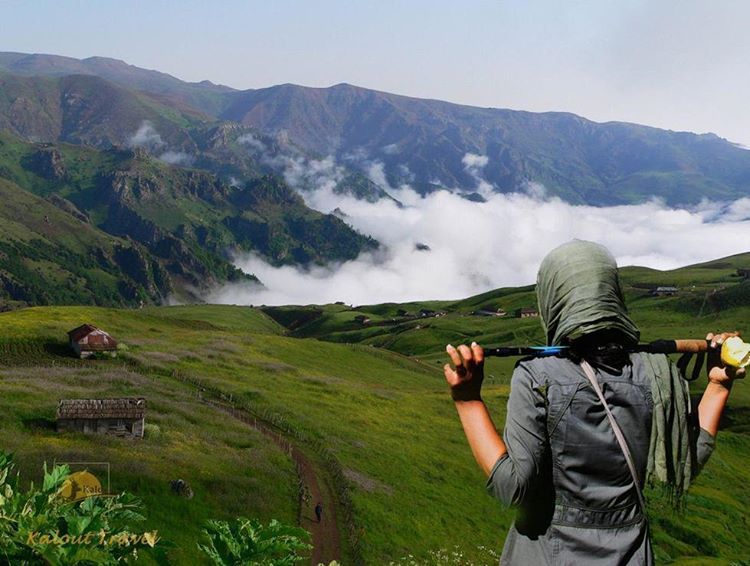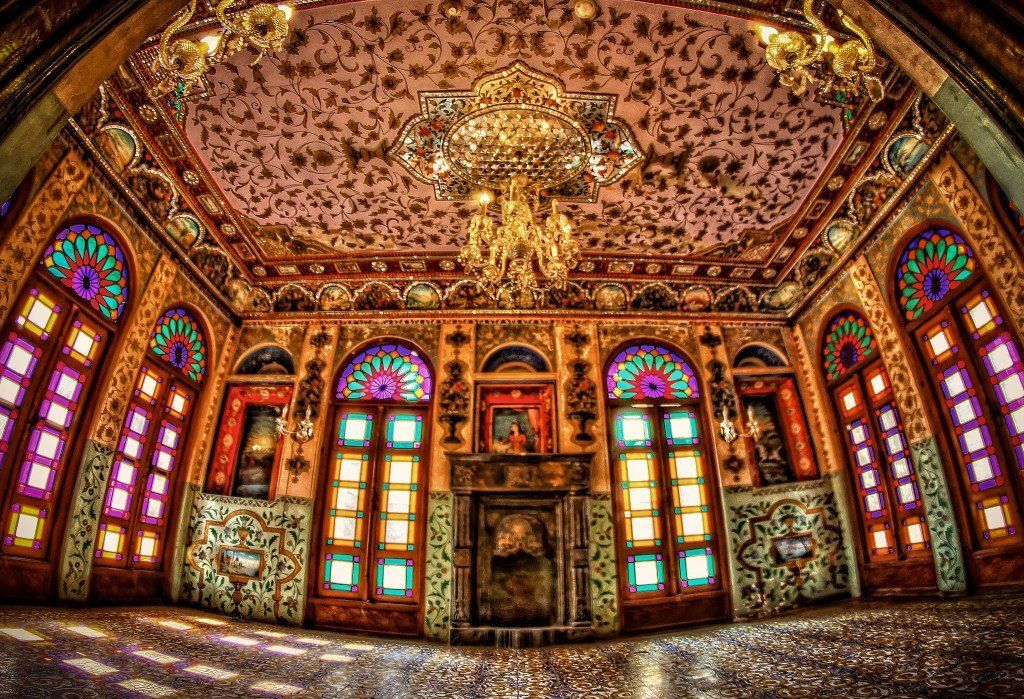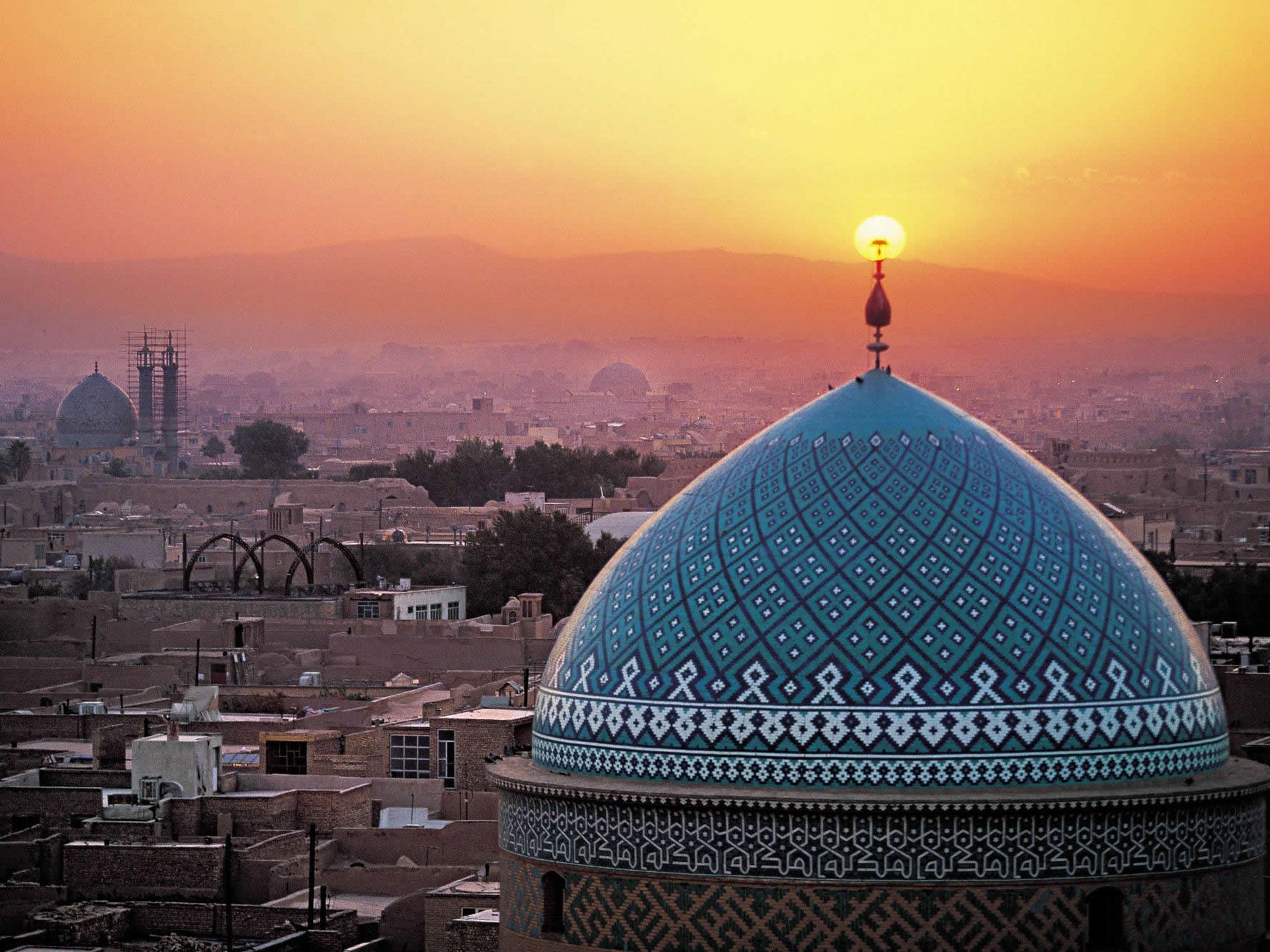Nowruz , The Iranian New Year at Present Times
Nowruz or No-Rooz, in word, means "New Day". It is the new day that starts the year, traditionally the exact astronomical beginning of the Spring. Iranians take that as the beginning of the year. This exact second is called "Saal Tahvil". No-Rooz with its' uniquely Iranian characteristics has been celebrated for at least 3,000 years and is deeply rooted in the rituals and traditions of the Zoroastrian (This was the religion of ancient Persia before the advent of Islam in 7th century A.D.).
Of all the Persian national festivals, the New Year celebrations are at once the most important and the most colorful. This festival embodies a wealth of ancient rites and customs. It symbolizes that continuity of the ancient Persian culture which has survived so many adversities and vicissitudes.
In harmony with the rebirth of nature, Nowruz always begins on the first day of spring marked by vernal equinox, or Tahvil. On that day -which may occur on March 20 – 21 or 22 – the sun crosses the celestial equator.
As far back as records go, Nowruz has been, either in fact or by intention, a celebration of early spring, when the sun begins to regain strength and overcome winter’s cold and darkness and when there is a renewal of growth and vigor in nature. Zoroastar’s people were demonstrably animatists, that is, they apprehended a cognitive spirit, mainyu, in all things, tangible or intangible. So for them this return of spring would have represented an annual victory for the spirit of the sun; and Zoroaster saw in it also, it appears, the symbol of a still more glorious victory to come. This was the special hope which he offered his followers, that the present struggle between good and evil, on all planes, physical, moral and spiritual, will end in total victory for the good.
Haft Sin
A few days prior to the New Year, a special cover is spread on to the Persian carpet or on a table in every Persian household. This ceremonial table is called cloth of seven dishes, (each one beginning with the Persian letter Sin). The number seven has been sacred in Persia since the ancient times, and the seven dishes stand for the seven angelic heralds of life-rebirth, health, happiness, prosperity, joy, patience, and beauty. The symbolic dishes consist of:
- Sabzeh or sprouts: Usually wheat or lentil representing rebirth.
- Samanu is a pudding in which common wheat sprouts are transformed and given new life as a sweet, creamy pudding and represents the ultimate sophistication of Persian cooking.
- Seeb means apple and represents health and beauty.
- Senjed the sweet, dry fruit of the Lotus tree, represents love. It has been said that when lotus tree is in full bloom, its fragrance and fruit make people fall in love and become oblivious to all else.
- Seer which is garlic in Persian, represents medicine.
- Somaq sumac berries, represent the color of sunrise; with the appearance of the sun Good conquers Evil.
- Serkeh or vinegar, represents age and patience.
To reconfirm all hopes and wishes expressed by the traditional foods, other elements and symbols are also on the sofreh):
- Most of the people used to place Qoran on their Sofreh (spread) in order to bless the New Year. But some people found another alternative to Qoran and replaced it by the Divan-e Hafez (poetry book of Hefez), and during "Saal Tahvil" reading some verses from it was popular. Nowadays, a great number of Iranians are placing Shahnameh (the Epic of Kings) of Ferdowsi on their spread as an Iranian national book. They believe that Shahnameh has more Iranian identity values and spirits, and is much suitable for this ancient celebration.
- A few coins placed on the sofreh represent prosperity and wealth.
- A basket of painted eggs represents fertility.
- A Seville orange floating in a bowl of water represents the earth floating in space.
- A goldfish in a bowl represents life and the end of astral year-picas.
- A flask of rose water known for its magical cleansing power, is also included on the tablecloth.
- Nearby is a brazier for burning wild rue, a sacred herb whose smoldering fumes ward off evil spirits.
- A pot of flowering hyacinth or narcissus is also set on the sofreh.
- A mirror which represents the images and reflections of creation as we celebrate a new the ancient Persian traditions and beliefs that creation took place on the first day of spring.
- On either side of the mirror are two candlesticks holding a flickering candle for each child in the family. The candles represent enlightenment and happiness.
History and origin of Nowruz
Ancient roots of Nowruz
Although it is not clear whether proto-Indo-Iranians celebrated a feast as the first day of the calendar, there are indications that Iranians may have observed the beginning of both autumn and spring, respectively related to the harvest and the sowing of seeds, for the celebration of the New Year. Boyce and Grenet explain the traditions for seasonal festivals and comment: "It is possible that the splendor of the Babylonian festivities at this season led the Iranians to develop their own spring festival into an established New Year feast, with the name Navasarda "New Year" (a name which, though first attested through Middle Persian derivatives, is attributed to the Achaemenian period)." Since the communal observations of the ancient Iranians appear in general to have been a seasonal ones, and related to agriculture, "it is probable that they traditionally held festivals in both autumn and spring, to mark the major turning points of the natural year."
Nowruz is partly rooted in the tradition of Iranian religions, such as Mitraism and Zoroastrianism. In Mitraism, festivals had a deep linkage with the sun light. The Iranian festivals such as Mehrgan (autumnal equinox), Tirgan, and the eve of Chelle ye Zemestan (winter solstice) also had an origin in the Sun god (Surya). Among other ideas, Zoroastrianism is the first monotheistic religion that emphasizes broad concepts; such as the corresponding work of good and evil in the world, and the connection of humans to nature. Zoroastrian practices were dominant for much of the history of ancient Iran. In Zoroastrianism, the seven most important Zoroastrian festivals are the six Gahambar festivals and Nowruz, which occurs at the spring equinox. According to Mary Boyce, "It seems a reasonable surmise that Nowruz, the holiest of them all, with deep doctrinal significance, was founded by Zoroaster himself"; although there is no clear date of origin. Between sunset on the day of the sixth Gahambar and sunrise of Nowruz, Hamaspathmaedaya (later known, in its extended form, as Frawardinegan; and today known as Farvardigan) was celebrated. This and the Gahambars are the only festivals named in the surviving text of the Avesta.
The 10th century scholar Biruni, in his work Kitab al-Tafhim li Awa'il Sina'at al-Tanjim, provides a description of the calendar of various nations. Besides the Iranian calendar, various festivals of Greeks, Jews, Arabs, Sabians, and other nations are mentioned in the book. In the section on the Iran calendar, he mentions Nowruz, Sadeh, Tirgan, Mehrgan, the six Gahambars, Farvardigan, Bahmanja, Esfand Armaz and several other festivals. According to him, "It is the belief of the Iranians that Nowruz marks the first day when the universe started its motion." The Persian historian Gardizi, in his work titled Zayn al-Akhbār, under the section of the Zoroastrians festivals, mentions Nowruz (among other festivals) and specifically points out that Zoroaster highly emphasized the celebration of Nowruz and Mehrgan.
Nowruz in Achaemenid period
It has been suggested that the famous Persepolis complex, or at least the palace of Apadana and the Hundred Columns Hall, were built for the specific purpose of celebrating a feast related to Nowruz. Although there may be no mention of the term Nowruz in recorded Achaemenid inscriptions, there is a detailed account by Xenophon of a Nowruz celebration taking place in Persepolis and the continuity of this festival in the Achaemenid tradition. It was an important day during the time of the Achaemenids (c. 550–330 BCE), where kings from different nations under the Achaemenid Empire used to bring gifts to the King of Kings of Iran. The significance of the ceremony in the Achaemenid Empire was such that King Cambyses II's appointment as the king of Babylon was legitimized only after his participation in the referred annual Achaemenid festival. It was, therefore, a highly auspicious occasion for the ancient Iranian peoples.
In 539 BC, the Jews came under Iranian rule, thus exposing both groups to each other's customs. According to the Encyclopædia Britannica, the story of Purim as told in the Book of Esther is adapted from an Iranian novella about the shrewdness of harem queens, suggesting that Purim may be a transformation of the Iranian New Year. A specific novella is not identified and Encyclopædia Britannica itself notes that "no Jewish texts of this genre from the Persian period are extant, so these new elements can be recognized only inferentially". The Encyclopaedia of Religion and Ethics notes that the Purim holiday is based on a lunar calendar, while Nowruz occurs at the spring equinox (solar calendar). The two holidays are therefore celebrated on different dates but within a few weeks of each other, depending on the year. Given their temporal associations, it is possible that the Jews and Iranians of the time may have shared or adopted similar customs for these holidays. The story of Purim as told in the Book of Esther has been dated around 625–465 BC (although the story takes place with the Jews under the rule of the Achaemenid Empire and the Jews had come under Iranian rule in 539 BC), while Nowruz is thought to have first been celebrated between 555–330 BC. It remains unclear which holiday was established first.
Nowruz in Arsacid and Sassanid periods
Nowruz was the holiday of Arsacid dynastic empires who ruled Iran (248–224 CE) and the other areas ruled by the Arsacid dynasties outside of Parthia (such as the Arsacid dynasties of Armenia and Iberia). There are specific references to the celebration of Nowruz during the reign of Vologases I (51–78 CE), but these include no details. Before Sassanids established their power in Western Asia around 300 CE, Parthians celebrated Nowruz in autumn, and the first of Farvardin began at the autumn equinox. During the reign of the Parthian dynasty, the spring festival was Mehrgan, a Zoroastrian and Iranian festival celebrated in honor of Mithra.
Extensive records on the celebration of Nowruz appear following the accession of Ardashir I, the founder of the Sasanian Empire (224–651 CE). Under the Sassanid emperors, Nowruz was celebrated as the most important day of the year. Most royal traditions of Nowruz, such as royal audiences with the public, cash gifts, and the pardoning of prisoners, were established during the Sassanid era and persisted unchanged until modern times
Nowruz after the Muslim conquest
Nowruz, along with Sadeh (celebrated in mid-winter), survived in society after the Muslim invasion of Iran in 650 CE. Other celebrations such the Gahambars and Mehrgan were eventually side-lined or were only followed by the Zoroastrians who carried them. It was adopted as the main royal holiday during the Abbasid period.
In the book Nowruznama ("Book of the New Year", which is attributed to Omar Khayyam, a well known Persian poet and mathematician), a vivid description of the celebration in the courts of the kings of Iran is provided:] "From the era of Kai Khosrow till the days of Yazdegard, last of the pre-Islamic kings of Iran, the royal custom was thus: on the first day of the New Year, Now Ruz, the king's first visitor was the High Mobad of the Zoroastrians, who brought with him as gifts a golden goblet full of wine, a ring, some gold coins, a fistful of green sprigs of wheat, a sword, and a bow. In the language of Iran, he would then glorify God and praise the monarch. This was the address of the High Mobad to the king: "O Majesty, on this feast of the equinox, first day of the first month of the year, seeing that thou hast freely chosen God and the faith of the ancient ones; may Sraosha, the angel-messenger, grant thee wisdom and insight and sagacity in thy affairs. Live long in praise, be happy and fortunate upon thy golden throne, drink immortality from the Cup of Jamshid; and keep in solemn trust the customs of our ancestors, their noble aspirations, fair gestures and the exercise of justice and righteousness. May thy soul flourish; may thy youth be as the new-grown grain; may thy horse be puissant, victorious; thy sword bright and deadly against foes; thy hawk swift against its prey; thy every act straight as the arrow's shaft. Go forth from thy rich throne, conquer new lands. Honor the craftsman and the sage in equal degree; disdain the acquisition of wealth. May thy house prosper and thy life be long!"
Following the demise of the caliphate and the subsequent re-emergence of Iranian dynasties such as the Samanids and Buyids, Nowruz was elevated to an even more important event. The Buyids revived the ancient traditions of Sassanian times and restored many smaller celebrations that had been eliminated by the caliphate. According to the Syrian historian Yaqut al-Hamawi, the Iranian Buyid ruler ʿAżod-od-Dawla (r. 949-83) customarily welcomed Nowruz in a majestic hall, wherein servants had placed gold and silver plates and vases full of fruit and colorful flowers. The King would sit on the royal throne (masnad), and the court astronomer came forward, kissed the ground, and congratulated him on the arrival of the New Year. The king would then summon musicians and singers, and invited his boon companions. They would gather in their assigned places and enjoy a great festive occasion.
Even the Turkic and Mongol invaders did not attempt to abolish Nowruz in favor of any other celebration. Thus, Nowruz remained as the main celebration in Iranian lands by both the officials and the people.
Nowruz Contemporary era
Before the collapse of the Soviet Union, Iran was the only country that officially observed the ceremonies of Nowruz. When the Caucasian and Central Asian countries gained independence from the Soviets, they also declared Nowruz as a national holiday.
The UN's General Assembly recognized the International Day of Nowruz in 2010, describing it as a spring festival of Iranian origin, which has been celebrated for over 3,000 years. During the meeting of The Inter-governmental Committee for the Safeguarding of the Intangible Heritage of the United Nations, held between 28 September – 2 October 2009, Nowruz was officially registered on the UNESCO List of the Intangible Cultural Heritage of Humanity. In response to the UN recognition, Iran unveiled a postage stamp. The stamp was made public in the presence of the Iranian President during the first International Nowruz Celebrations in Tehran on Saturday, 27 March 2010.
The second International Nowruz Celebrations were also held in Tehran in 2011. The 3rd International Nowruz Celebrations were held in Dushanbe, Tajikistan, on March 25, 2012 with Tajik President and his Iranian and Afghan counterparts in attendance. The next international ceremonies to celebrate Nowruz were scheduled to be hosted by Turkmenistan.
Chaharshanbe Souri
The actual Nowruz ceremonies begin on the eve of the last Wednesday of the outgoing year. Early in the evening of that day, referred to as chaharshanbe souri or “Red Wednesdayˮ, several rather large bonfires are made; every member of the family jumps over the fire and says, “sorkhi-e to az man, zardi-e man az toˮ, which literally means “Give me your redness and take away my wintry sallow complexionˮ. The jumping over the fire is followed by a get together in which nuts and fruits are served. This party is mostly for the benefit of the children of the family who are entertained, long into the night, with stories that they will remember with joy throughout their lives.
While the party goes on the fire dies out. The ashes are gathered and, as the symbol of the bad luck imposed by winter, are taken out of the house and buried in the fields.
Amu Nowruz and Haji Firuz
In Iran, the traditional heralds of the festival of Nowruz are Amu Nowruz and Haji Firuz, who appear annually in the streets to celebrate the New Year.
Amu Nowruz brings children gifts, much like his Christian counterpart Santa Claus. He is the husband of Nane Sarma, who shares a traditional love story with him in which they can meet each other only once a year. He is characterized as an elderly silver-haired man who puts on a felt hat, and has a walking stick, a long cloak of blue canvas, a sash, a pair of thin-soled giveh, and a pair of linen trousers.
Haji Firuz, with his face covered in soot, is clad in bright red clothes and a felt hat. He dances through the streets while singing and playing a tambourine, and is the companion of Amu Nowruz. In the traditional songs, he introduces himself as a serf trying to cheer people who he refers to as his lords. As a blackfaced serf, it is a controversial character, reviewed as a racist symbolism.Therefore, half of his face is sometimes painted white in order to prevent the criticisms.
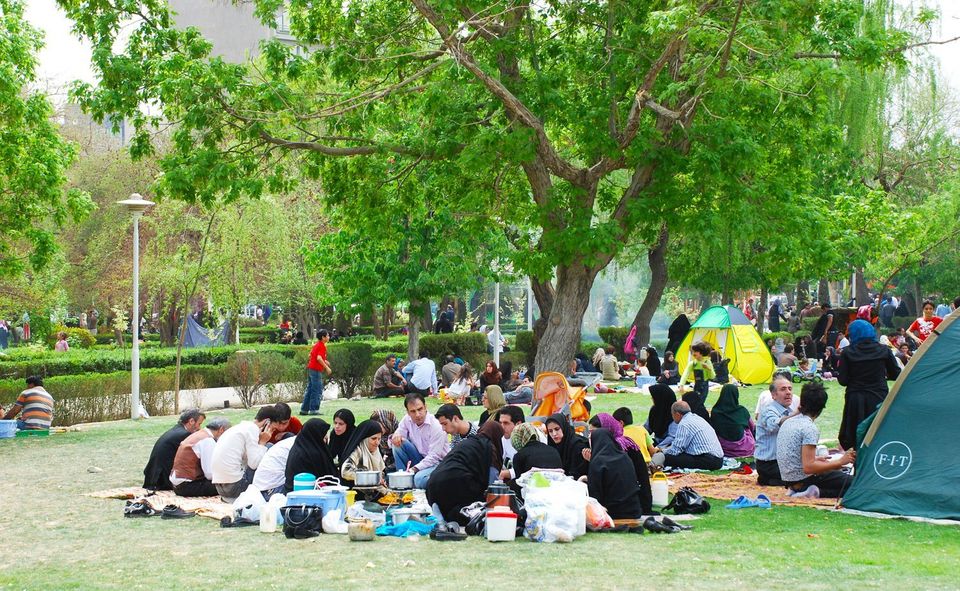
Sizdah Bedar
The thirteenth day of the New Year festival is called Sizdah Bedar (meaning «thirteen outdoors») or day of nature. On this day people go out in the nature in groups and spend all day outdoors in the nature in form of family picnics. It is a day of festivity in the nature, where children play and music and dancing is abundant. On this day, people throw their sabzeh away in the nature as a symbolic act of making the nature greener, and to dispose of the bad luck that the sprouts are said to have been collecting from the household.
The thirteenth day celebrations, Seezdah Bedar, stem from the belief of the ancient Persians that the twelve constellations in the Zodiac controlled the months of the year, and each ruled the earth for a thousand years. At the end of which, the sky and the earth collapsed in chaos. Hence, Nowruz lasts twelve days and the thirteenth day represents the time of chaos when families put order aside and avoid the bad luck associated with the number thirteen by going outdoors and having picnics and parties.
House cleaning and shopping
House cleaning, or shaking the house (خانه تکانی – xane tekāni) as referred to by Persian-speaking Iranians, is commonly performed before the arrival of Nowruz. People start preparing for Nowruz with a major spring-cleaning of their house and the purchase of new clothes to wear for the New Year, as well the purchase of flowers. In particular, the hyacinth and the tulip are popular and conspicuous.
In association with the "rebirth of nature," extensive spring cleaning is a national tradition observed by almost every household in Iran. This is also extended to personal attire, and it is customary to buy at least one set of new clothes.
Parsis adorn their houses with different auspicious symbols; namely, stars, butterflies, birds and fish. They order and make new attires especially for the festival. On the day of Navroz, they dress in their new and best clothes and put on gold and silver kustis and caps. They decorate the doors and windows with garlands of roses and jasmines, and use color powders for creating patterns known as rangoli on the steps and thresholds. Fish and floral motifs are a favorite among rangolis and considered highly auspicious.
Visiting one another
During the Nowruz holidays, people are expected to visit one another (mostly limited to families, friends and neighbors) in the form of short house visits, which are usually reciprocated. Typically, the youth will visit the elders first, and the elders return their visit later.
In Iran, the visits naturally have to be relatively short, otherwise one will not be able to visit everybody on the list. A typical visit is lesser than 30 minutes, where you often run into other visiting relatives and friends who happen to be paying a visit to the same house at that time.
Because of the house visits, you make sure you have a sufficient supply of pastry, cookies, fresh and dried fruits and mixed nuts on hand, as you typically serve your visitors with these items with tea and other beverages. Many Iranians will throw large Nowruz parties in a central location as a way of dealing with the long distances between groups of friends and family.
Mythology of Nowruz
There exist various foundation myths for Nowruz in Iranian mythology.
The Shahnameh dates Nowruz as far back to the reign of Jamshid, who in Zoroastrian texts saved mankind from a killer winter that was destined to kill every living creature. Jamshid, the mythical Iranian king, perhaps symbolizes the transition of the proto-Iranians from animal hunting to animal husbandry and a more settled life in human history. In the Shahnameh and Iranian mythology, he is credited with the foundation of Nowruz. The book reads that Jamshid constructed a throne studded with gems. He had demons raise him above the earth into the heavens; there he sat on his throne like the sun shining in the sky. The world's creatures gathered in wonder about him and the scattered jewels around him, and called this day the New Day (Now Ruz). This was the first day of Farvardin, which is the first month of the Iranian calendar.
Astronomy of Nowruz
The first day of the Iranian calendar falls on the March equinox, the first day of spring, around 20 March. At the time of the equinox, the sun is observed to be directly over the equator, and the north and south poles of the Earth lie along the solar terminator. Sunlight is evenly divided between the north and south hemispheres.
In around the 11th century CE, major reforms of the Iranian calendars took place and whose principal purpose were to fix the beginning of the calendar year, i.e. Nowruz, at the vernal equinox. Accordingly, the definition of Nowruz given by the Iranian scientist Tusi was the following: "the first day of the official New Year [Nowruz] was always the day on which the sun entered Aries before noon.
Calendar
In the Fasli/Bastani variant of the Zoroastrian calendar, Navroz is always the day of the vernal equinox (nominally falling on March 21).
In the Shahenshahi and Kadmi calendars, which do not account for leap years, the New Year's Day has drifted ahead by over 200 days. These latter two variants of the calendar, which are only followed by the Zoroastrians of Pakistan and India, celebrate the spring equinox as Jamshed-i Nouroz, with New Year's Day then being celebrated in July–August as Pateti "(day) of penitence" (from patet "confession," hence also repentance and penitence).
Nowruz in religions
Apart from Zoroastrianism, Nowruz has been entered into the contexts of some other religions and faiths.
There exist narrations in the Shia literature about the merits of the day of Nowruz, including the fact that the Day of Ghadir was on that day, and also the recommendation to fast on the day of Nowruz, the latter appearing in the fatwas of major Shia scholars.
Nowruz is also a holy day for Sufis, Bektashis, Ismailis, Alawites, Alevis and Babis.
Otras lecturas:




































